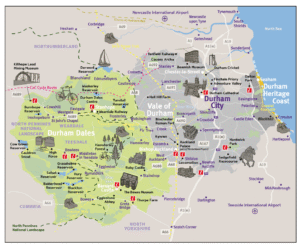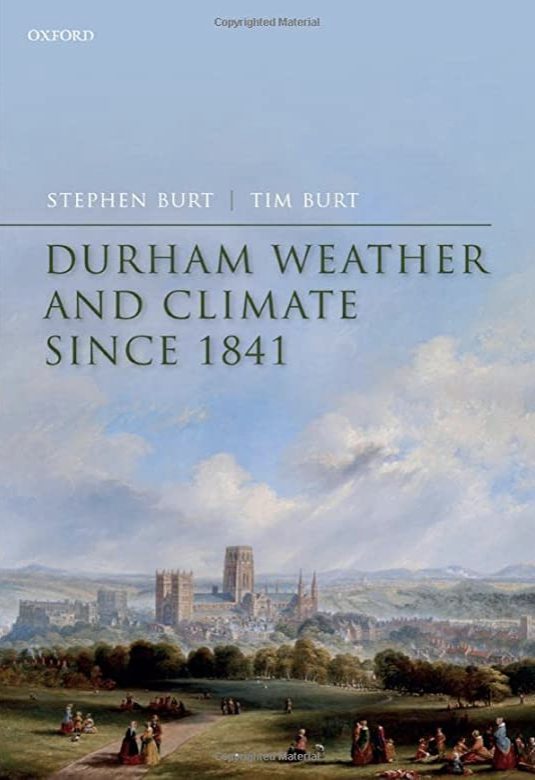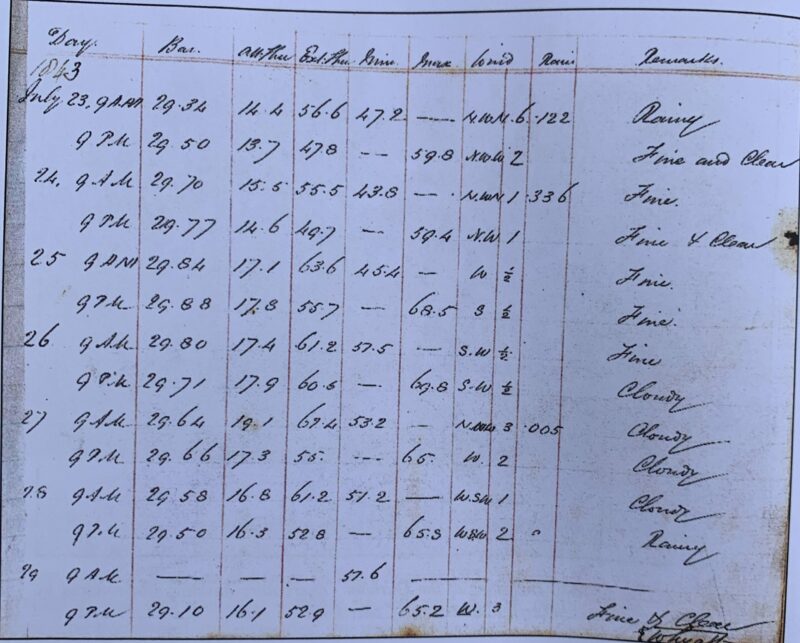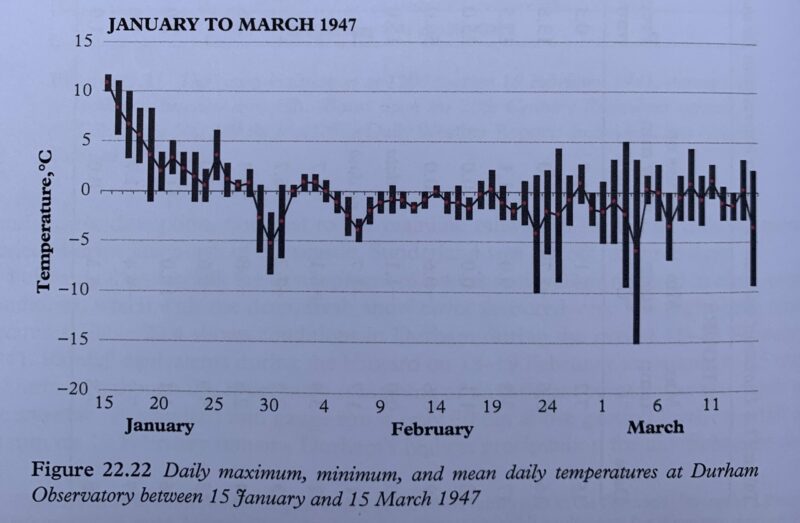The British have always been obsessed by the weather. Astronomers at Durham Observatory began weather observations in 1841; weather records continue unbroken to this day, one of the longest continuous series of single-site weather records in Europe. Durham Weather and Climate since 1841 represents the first full publication of this newly digitised record of English weather, which will be of lasting appeal to interested readers and climate researchers alike.
The book celebrates 180 years of weather in north-east England by describing how the records were (and are) made and the people who made them, examines monthly and seasonal weather patterns and extremes across two centuries, and considers long-term climate change.
Local documentary sources and contemporary photographs bring the statistics to life, from the great flood of 1771 and skating on the frozen River Wear in February 1895 right up to Durham’s hottest-ever day in July 2019 and its wettest winter in 2021.
Extensive links are provided to full daily weather records back to 1843. This volume is a sister publication to Oxford Weather and Climate since 1767 by the same authors, published by Oxford University Press in 2019.
Review
Durham University has a venerable history of observational climate science. When Gordon Manley, perhaps the greatest British climatologist of the 20th century, arrived in Durham in 1928 to establish the Department of Geography, he resolved to place the Durham Observatory weather records on the same basis as those of the Radcliffe Observatory in Oxford, which had long been recognised as a valuable resource. This book updates and extends Manley’s pioneering work. ― Karen O’Brien, Vice-Chancellor, Durham University
This definitive book beautifully discusses the variations in the weather and climate in Durham over nearly two centuries, including all the highs and lows. The long-term view provided by these detailed records clearly highlights the warming of our climate and the fingerprint of human influence on our weather, even at this local scale. ― Ed Hawkins MBE, University of Reading, UK
This lovingly-crafted history will be the envy of all long-term weather stations around the world. Tim and Stephen have respectfully interpreted the painstaking efforts of those who came before them, delivering an engaging and useful volume which transports you to the University grounds throughout the seasons and the decades.
As the Earth continues to warm, these kinds of careful histories will only become more important. ― Linden Ashcroft, The University of Melbourne, Australia
Durham Weather and Climate since 1841 undertakes a comprehensive rescue and analysis of this hugely valuable long-term meteorological station record including an in-depth reconstruction of the station history.
The resulting meticulous data analysis provides key new insights into long-term UK climate changes that are essential to understanding our rapidly changing climate. ― Peter Thorne, ICARUS Climate Research Centre, Maynooth University, Ireland
Climate science relies on long, carefully re-evaluated meteorological records. It is this long-term view that allows changes in weather and climate to be assessed and put into perspective. In Durham Weather and Climate since 1841, Tim Burt and Stephen Burt, two widely-known experts in the field, present another long record.
The book describes the history of weather and climate in northern England and the role of weather in daily lives. It tells the story of meteorological measurements in Durham, which at the same time is a story about astronomy, the University and about the life-long dedication of individuals such as Gordon Manley – and the authors of this book. ― Stefan Brönnimann, University of Bern, Switzerland
Durham has long been known for its eminence in meteorology and climatology. In this beautifully illustrated volume, Stephen Burt and Tim Burt place Durham’s long record of observations in their complete historical and social context.
They describe the struggles and accomplishments of the observers, both the famous and those who quietly carried out their daily duties. Burt and Burt take these centuries’ worth of observations and turn them into analytical descriptions of Durham’s climate, month by month and season by season, linking climatic events with citizen’s daily lives.
Packed with statistics, meteorological and climatological analysis, and historical commentary, this will be of interest to anyone interested in long-term climate change, observational records, historical climatology, weather analysis and the history of meteorology. ― Victoria Slonosky, McGill University, Montreal, Canada
Durham provides an excellent record for discussing climate change in north-east England and for a wider area. ― Chris Folland, Met Office, Exeter, UK
While the Durham record is less well-known than the Oxford one, it is still impressive and its analysis will give a picture of a very different location. Climate change is an increasingly significant issue. The volume is very timely. ― Andrew Goudie, University of Oxford
About the Authors
Dr Stephen Burt has published widely on many and varied aspects of British climatology, including case studies of notable weather events including gales, snowstorms, heatwaves and thunderstorms, and citizen science data rescue projects including the hourly Ben Nevis Observatory records and 350 years of Met Office rainfall data.
He is a Fellow of the Royal Meteorological Society and a member of the American Meteorological Society and the Scientific Instruments Society. Previous books include Oxford Weather and Climate since 1767 (with Tim Burt) and The Weather Observer’s Handbook. He is a Visiting Fellow in the Department of Meteorology at the University of Reading.
Tim Burt retired in 2017 after 21 years as Master of Hatfield College and Professor of Geography at Durham University. Before that, he was Lecturer in Physical Geography at Oxford University and a Fellow of Keble College (1984-96) and Director of the Radcliffe Meteorological Station (1986-96). Tim has run the Durham Observatory weather station since 2001, not as old as the Radcliffe, but still with records dating from 1843.
Tim has published widely on the Durham and Oxford records as well as in other areas of physical geography (notably, hydrology and water quality, fluvial geomorphology). He is now an Emeritus Professor at Durham University and a Visiting Professor at the University of Bristol. An undergraduate at Cambridge, Tim has an MA from Carleton University, Ottawa, and a PhD and DSc from the University of Bristol.
Available at Amazon here:
Latest Editorial Posts
- Durham Live Weather Data Is Now Available
 The Eagle-eyed among you may have noticed a ‘Live Durham Weather’ option has appeared in the header bar. Clicking this will take you to the following page views. You’ll be …
The Eagle-eyed among you may have noticed a ‘Live Durham Weather’ option has appeared in the header bar. Clicking this will take you to the following page views. You’ll be … - How a Plastic Bin Fooled My Weather Station
 Sometimes, in the world of amateur meteorology, it’s not the technology that trips you up. It’s the humble bin. Yes, a bog-standard plastic bin. And not doing anything remotely interesting, …
Sometimes, in the world of amateur meteorology, it’s not the technology that trips you up. It’s the humble bin. Yes, a bog-standard plastic bin. And not doing anything remotely interesting, … - Cathedrals, collieries, castles and coastlines
 County Durham—my own stomping ground. It’s a place that doesn’t get nearly enough credit for its beauty, charm, and personality. Tucked neatly between Northumberland to the north and Yorkshire to …
County Durham—my own stomping ground. It’s a place that doesn’t get nearly enough credit for its beauty, charm, and personality. Tucked neatly between Northumberland to the north and Yorkshire to … - Exploring the Serene Beauty of England’s River Wear
 Exploring the Serene Beauty of England’s River Wear Nestled within the picturesque landscapes of Northeast England, between the Tyne to the North and the Tees to the South, the River …
Exploring the Serene Beauty of England’s River Wear Nestled within the picturesque landscapes of Northeast England, between the Tyne to the North and the Tees to the South, the River … - About our Visitors to Durham Weather
 What do people search for at Durham Weather? Here at Durham Weather, we are always interested in what others are searching for when they find us. The weather is of …
What do people search for at Durham Weather? Here at Durham Weather, we are always interested in what others are searching for when they find us. The weather is of … - What are the most important things to consider when buying a weather station for the home?
 How to choose a Weather Station When buying a weather station for the home, there are several important things to consider: Accuracy: The most important feature of any weather station …
How to choose a Weather Station When buying a weather station for the home, there are several important things to consider: Accuracy: The most important feature of any weather station …


